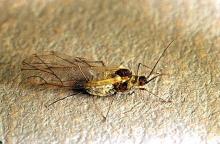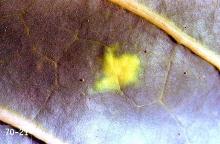Numerous species
Pest description and crop damage Aphids are soft-bodied insects with piercing-sucking mouthparts. They are usually identified by the host plant, and characters such as wing venation, antennae, and cornicles. The same species can vary in color, shape, and size depending on the time of the year. Crop damage includes distorted plant growth, particularly terminals, shiny honeydew, black sooty mold (which can grow on the honeydew), waxy deposits (some species), yellowing, and general plant decline.
Biology and life history There are winged (alate) aphids that can migrate, and wingless adult aphids which remain on the host but can reproduce asexually, producing large aphid populations quickly. Most aphids are associated with one or several host plants. Some have alternate hosts, overwintering on one host and moving to another as the season progresses. Several species, including many common in greenhouses, have a wide host range, with many host plants including weed species. Examples of these species include green peach aphid (Myzus persicae), cotton or melon aphid (Aphis gossipea), potato aphid (Macrosiphum euphorbiae), and cabbage aphid (Brevicoryne brassacae).
Scouting and thresholds Scout for aphids near growing terminals and leaf undersides, particularly alongside leaf veins. White cast skins, shiny honeydew, black sooty mold, and misshapen terminals are good indicators of aphid presence. Yellow sticky traps and yellow pan traps can help monitor flights of adults.
Management-biological control
Natural enemies include:
- hoverflies, many species-Maggot-like larvae are voracious predators of aphids. Pollen and nectar-feeding adults are commonly seen around flowers.
- lacewings (Chrysopa spp., Chrysoperla carnea, C. rufilabris, C. comanche)-Some species commercially available.
- lady beetles (Hippodamia convergens, Harmonia axyridis, Coleomegilla maculate, Coccinella septempunctata)-Note: Use of non-local, wild-harvested lady beetles is discouraged due to potential movement of lady beetle pathogens and parasites.
- pirate bugs (Orius spp.)-Some species commercially available. Both adults and larvae are predators of small eggs, insects, and mites.
- parasitoid wasps (Aphidius ervi, A. matricariae, A. colemani, Aphelinus abdominalis, Diaeretiella rapae, Lysiphlebus testaceipes, Trioxys pallidus)-Some species commercially available. Many parasitoids have preferred hosts. See specific aphid for more information.
- predatory midge (Aphidoletes aphidimyza)-Commercially available and has given good control. Maggot-like larvae are voracious predators of aphids. Adults may go into diapause with low light or short days.
Management-chemical control
Good spray coverage, including the underside of leaves, is important. Aphids excrete honeydew which attracts ants. Ants may need to be controlled by an under-bench treatment before releasing biological control agents.
- abamectin (Avid 0.15EC) at 0.009 lb ai/100 gal (8 fl oz). REI 12 hr. For suppression only.
- acephate (Precise, Orthene TR) at 0.024 lb ai/1,000 sq ft broadcast (0.6 oz). REI 24 hr.
- acetamiprid (Tristar 30SG) at 0.24 lb ai/100 gal (1.3 oz). REI 12 hr.
- afidopyropen (Ventirgra) at 4.0 fl oz with non-ionic spreader/sticker per 100 galazadirachtin (Azahar, Azatin XL)-Insect growth regulator, antifeedant. Some formulations are OMRI-listed for organic use.
- azadirachtin (AZA-Direct Botanical Insecticide, Azaguard)-Unknown/uncertain mode of action. Can be applied aerial, ground or irrigation.
- Beauvaria bassiana (Botanigard, Mycotrol, Naturalis L)-Works by contact, good coverage required. Some formulations are OMRI-listed for organic use.
- beta-cyfluthrin (Tempo)-1 to 3 packets per gal water depending on infestation level.
- bifenthrin (Talstar) at 0.084 to 0.168 lb ai/1,000 sq ft. REI 12 hr. Restricted use pesticide.
- bifenthrin/ clothianidin (Aloft)-Liquid and granular ground application or mulch application
- bifenthrin/zeta-cypermethrin/ imidacloprid (Triple Crown Golf Insecticide) 2.5 to 7.5 fl oz per 100 gal; target application to areas where pests are active, use sufficient water to thoroughly wet plant surfaces
- Burkholderia spp. (Venerate XC) at 4 to 8 pints per 100 gal.
- canola oil (various RTU products)-Good contact is essential. Some formulations are OMRI-listed for organic use.
- chlorpyrifos (Vulcan) at 1/12 to 1/6 fl oz per gal or 0.5 to 1.0 pint per 100 gal, no more than 2.8 quarts per acre/year
- Chromobacterium (Grandevo) at 1 to 3 lb/A depending on specific crop.
- cinnamaldehyde (Seican)-Foliar spray. Maximum rate of 3.5 pints/A.
- cinnamon oil (Cinnerate) at 50 to 210 gal/A
- citric acid (PureAg, Trishield) 1.5-2.0 oz per gallon for infestations, 1.0 oz/gal for maintenance
- clothianidin (Arena 0.25G) at 0.315 to 0.63 oz ai/100 gal. REI 12 hr. Soil treatment refer label.
- clove oil (Nature-cide All-Purpose)
- corn oil (Circadian Sunrise) at 1.0 to 3.0 oz/gal.
- cotton seed oil (Furious) at 22 to 33 fl oz/A or 3 fl oz/gal for 1,000 sq ft. WA only.
- cyantraniliprole (Mainspring GNL) at 0.16 lb ai/100 gal drench. REI 4 hr.
- cyclaniliprole/flonicamid (Pradia) at 10 to 17.5 fl oz/100 gal.
- cyfluthrin (Decathlon 20WP) at 1.9 oz/100 gal. REI 12 hr.
- cyfluthrin/imidacloprid (Discus L) at 0.063 lb ai/100 gal foliar; 0.009 to 0.014 lb ai/1,000 ft soil. REI 12 hr.
- cyhalothrin (Declare, Scion) at 0.0 to 0.0lb/A or 1.0 to 2.06 fl oz/A. Do not apply more than 0.12 lb active ingredient (0.77 pints) per acre per year. Declare is a Restricted Use Pesticide
- cypermethrin (Demon) at 33 oz/100 gal, sprayer output at 1.0 gal per 1,000 sq ft.
- DDVP (nuvan fog 5%) use is prohibited on food plants
- deltamethrin (D-Fense Dust) at 8 oz product per 1,000 sq ft or as a thin layer.
- diatomaceous earth (Perm Guard Garden and Plant)-Application varies between dry and wet application types, refer to label for rates.
- dinotefuran (Safari 20SG) at 0.1 to 0.2 lb ai/1,000 ft sq; 0.05 to 0.1 lb ai/100 gal. REI 12 hr.
- fenpropathrin (Valent Tame 2.4 EC)-Apply as tank mix with Orthene Turf, Tree and Ornamental Spray.
- flonicamid (Aria) at 0.022 to 0.067 lb ai/100 gal. REI 12 hr.
- flupyradifurone (Altus) at 7.0 to 10.5 fl oz/A. REI 4 hr.
- geraniol, rosemary and peppermint oils (Keyplex Ecotrol Plus)-Topical mixed at 20 to 40 fl oz/gal.
- GS-omega/kappa-hxtx-hv1a (Spear T)-Use in high pressure, low volume spray and fogging equipment in greenhouses at 1 to 3 gal per 100 gal water
- imidacloprid (Marathon II) at 0.027 oz ai/100 gal foliar. REI 12 hr. Drench and irrigation permitted.
- Isaria fumosorosea (PFR 97) at 0.175 to 3.5 lb ai/100 gal foliar. REI 4 hr.
- kaolin (Surround)-Some formulations are OMRI-listed for organic use. May leave residue.
- lambda-cyhalothrin (Scimitar GC) at 0.013 to 0.043 lb ai/100 gal. REI 24 hr.
- methiocarb (Mesurol 75W) at 0.375 to 0.5 lb ai/100 gal. REI 12 hr. Restricted use pesticide.
- mineral oil/petroleum distillate (Biocover LS)
- naled (Dibrom 8)-Application varies by application type and crop.
- neem oil (Nimbiosys Neem Oil) at 1 to 2 pints/A using a 0.5% concentration; for very heavy pest pressure, use up to 3.5 pints/A in a 1.1% solution
- permethrin (Pounce 25 WP)-Application rates depend on specific host plant.
- piperonyl butoxide (Pyrethrum TR, Evergreen Pro, Pyrenone Crop Spray and others)-Refer to labels for specific application rates.
- potassium laurate (Kopa Insecticidal Soap) 2 gal prod/100 gal water
- pymetrozine (Endeavor) at 1.25 to 2.5 oz ai/100 gal. REI 12 hr.
- pyrethrins (E.B. Stone, Earth-tone, Worryfree)-Good contact essential. Some formulations are OMRI-listed for organic use.
- pyridiben (Sanmite SC) at 6.4 to 9.6 oz/A or 0.15 to 0.22 oz per 1,000 sq ft.
- pyrifluquinazon (Rycar) at 0.034 to 0.045 lb ai/100 gal. REI 12 hr. Limit 2 treatments per crop.
- pyriproxifen (Distance) at 0.041 to 0.054 lb ai/100 gal (6 to 8 fl oz) foliar. REI 12 hr. Suppression.
- s-kinoprene (Enstar AQ) at 0.012 to 0.024 lb ai/10,000 sq ft. REI 4 hr.
- sodium borate (Prev-Am) fungicide + insecticide-Label rates vary by application type
- soybean oil (Golden Pest)-Dilute 1 to 3 gal per 100 gal water.
- spinetoram, sulfoxaflor (XXPire) at 0.06 to 0.08 oz/3 gal or 2.0 to 2.75 oz/100 gal.
- spirotetramat (Kontos) at 0.027 to 0.053 lb ai/100 gal. REI 24 hr.
- tau-fluvalinate (Mavrik Aquaflow) at 0.063 to 0.156 lb ai/100 gal. REI 12 hr.
- thiamethoxam (Flagship 25WG) as fogger-REI 12 or 24 hr.
- tolfenpyrad (Hachi-Hachi) at 0.14 to 0.33 lb ai/100 gal. REI 12 hr.







